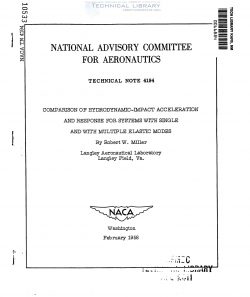naca-tn-4194
- Version
- 154 Downloads
- 1.14 MB File Size
- 1 File Count
- February 3, 2017 Create Date
- February 3, 2017 Last Updated
National Advisory Committee for Aeronautics, Technical Notes - Comparison of Hydrodynamic-Impact Acceleration and Response for Systems with Single and with Multiple Elastic Modes

Hydrodynamic-impact tests were made with a multimode elastic model
consisting of a rigid prismatic float and a flexible wing, and the
results were compared with similar emerimental results for a single—
mode system and with theoretical solutions. The model had a ratio of
sprung mass to hull mass of O.h8 and a first-mode natural frequency of
n.58 cycles per second. The tests were conducted in smooth water at
fixed trims of 5° and 9° with flight-path angles of 111—0 and 6°, respec-
tively, and over a range of velocity.
The analysis of the data and comparisons with other experimental
and theoretical results indicated that the applied accelerations were
in agreement with those obtained by the method of NAGA.Report 107% and
that the higher modes present in the multimode system had no significant
effect on the applied accelerations.
The development of large airplanes has caused the elastic behavior
of airframe structures to become important. Considerable effort is being
expended in attempts to evaluate the effects of this behavior on the
externally applied dynamic loading of large airplanes during gusts,
maneuvers, and landing impacts. In the case of water landings, this has
reference to changes in the applied hydrodynamic force due to elastic
action of the entire hull-wing structure and is not concerned with the
highyfrequency reactions of individual hull-bottom panels.
In reference I, an analytical method for treating water landing of
an elastic seaplane was presented in which interaction of the applied
load and structural reSponse was included, and it was shown that struc-
tural flexibility may have appreciable effects on the applied load. In
reference I, the elastic structure was represented by the assumption of
a rigid prismatic float connected by a massless spring to a rigid upper
mass, and the solutions were based on hydrodynamic theory which had been
experimentally confirmed for a rigid structure. Reference 2 substanti—
ated these results by water-impact tests with an elastic model approxi-
mating the two-mass——5pring system which consisted of a rigid prismatic
float and a lightweight flexible wing supporting a concentrated mass on
each tip.
The present tests made use of the model used in the investigation
reported in reference 2, but the upper mass was distributed as uniformly
as possible along the wing Span instead of being concentrated at the
tips. The purpose of testing this configuration was to detenmine the
integrated influence of the higher modes of vibration present on the
applied hydrodynamic loads and the validity of the two—mass—system
approximation to the actual case where the masses are, in general, not
concentrated on a weighthess wing but distributed along the span.
| File | Action |
|---|---|
| naca-tn-4194 Comparison of Hydrodynamic-Impact Acceleration and Response for Systems with Single and with Multiple Elastic Modes.pdf | Download |

Comment On This Post